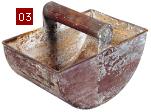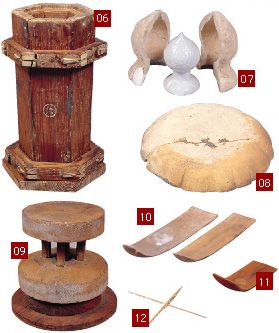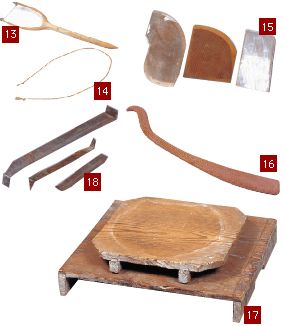 |
 |
|
01 - Pickax
Tool for quarrying porcelain stone, which
have been used until recently
02 - inyatebo
Also called "ninaitebo", used hanging
at each end of a pole for carrying stone. |
 |
| |
  |
03 - choppage (ladle)
Used to ladle water containing powdered clay. |
 |
| |

 |
04 - Paddling wheel
Wheel for paddling. A piece is formed with
a wooden paddle on a wheel that is being
turned using one hand.
05 - Wooden paddle
Used for paddling a piece into shape or to
make it stronger and finer at the bottom.
06 - Wooden mold
Used for forming by pressing clay directly
onto it
07 - Clay mold (for kataoshi interior mold
making process)
Used for forming by pressing clay directly
onto it
08 - Clay mold (for katauchi press mold making
process)
Used for forming by placing a half dry piece
formed on a wheel over the mold.
09 - Kerokuro (kick-wheel in comparison with
hand-wheel)
Used for forming by kicking to turn and usually
called 'kuruma (wheel)' in Arita.
10 - Spatula (nobebera)
Used to spread clay to the shape of a piece
of ware when forming on the wheel.
11 - Spatula (binbera)
Used especially to spread clay on the mouths
of vases and jars in wheel-forming.
12 - Tonbo
Used to measure the depths and diameters
of pieces of ware in wheel-forming.
13 - Kiriyumi
Used to cut extra clay off a piece in wheel-forming.
14 - Kiriyoma
Made of horse-tail hair or straw and used
to release a finished product from the wheel.
15 - Spatula (oshibera)
Used for finishing in wheel-forming.
16 - Spatula (naginata-bera)
Used to finish vases in wheel-forming.
17 - Hassun
Used as a plate for larger pieces when drying
after forming.
18 - kana (plane)
Dialect for 'kanna' in Arita. Used to plane
formed and dried pieces into shape. |
| |
# All the tools are owned by the Arita Museum
of Folk Materials. |
|

